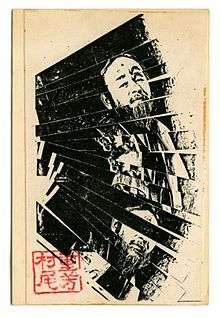Shig Murao
Shigeyoshi "Shig" Murao (December 8, 1926 – October 18, 1999) was a Japanese-American bookseller who is mainly remembered as the City Lights clerk who was arrested on June 3, 1957, for selling Allen Ginsberg's Howl to an undercover San Francisco police officer.[1] In the trial that followed, Murao was charged with selling the book and Lawrence Ferlinghetti with publishing it. Murao and Ferlinghetti were exonerated and Howl was judged protected under the First Amendment, a decision that paved the way for the publication of Henry Miller, D.H. Lawrence, William Burroughs, and many other writers who offended puritanical elements of society.[2]
Shigeyoshi "Shig" Murao | |
|---|---|
 Self portrait photo-collage of Shig Murao | |
| Born | December 8, 1926 |
| Died | October 18, 1999 (aged 72) |
| Nationality | United States of America |
| Occupation | Manager of City Lights Bookstore |
| Conviction(s) | Not guilty |
| Criminal charge | Sale of obscene material |
Murao and his twin sister Shizuko were born on December 8, 1926, in Seattle, Washington. In 1942, following the attack on Pearl Harbor, Murao and his family were interned at the Minidoka War Relocation Center, Idaho. He joined the Military Intelligence Service in 1944, and worked in post-war Japan as an interpreter.[3]
Ferlinghetti and Peter Martin, the co-founder of City Lights, hired Murao as a clerk soon after the store opened in June 1953. Murao worked without pay for the first few weeks, but eventually became the manager of the bookstore,[4] and his genial personality set the tone for the bookstore.[5] He continued in that position until 1976, building friendships with many of the Beat icons, including Ginsberg, who became a close friend and would stay at Murao's Grant Avenue apartment when visiting the Bay Area.[6] Murao suffered the first in a series of strokes in the fall of 1975. When he returned to work Ferlinghetti wanted to bring in new management. Murao refused this arrangement and walked away from the store that had been his life. Murao and Ferlinghetti never reconciled.[7]
Murao was not a poet, but he played a key role in the San Francisco Beat scene and had a large circle of friends, including Ginsberg, Michael McClure, Gary Snyder, Richard Brautigan, and many other literary and Beat-era figures. After his separation from City Lights, he held court in the Caffe Trieste and published a photocopied zine called Shig's Review.[8]
The first three issues of Shig's Review, published in 1960 and 1969, were printed and bound. Beginning in 1983, Murao revived the review as a photocopied zine. He would take a collection of poems, photos, poetry reading fliers, or his own collages to a copy shop and make twenty or thirty copies. He would then staple them in the corner, put his hanko on the cover in red ink, and walk down to the Caffe Trieste, where he would give them to his friends. Murao published about eighty issues of the quirky review before his death.[9]
In the nineties Murao moved to an assisted living home in Palo Alto, California, and briefly recreated his life in North Beach, visiting cafes and bookstores in an electric wheelchair. After an accident in the wheelchair, he moved to a convalescent hospital in Cupertino, California, where he died in 1999.[8]
Notes
- Bill Morgan and Nancy Peters, Howl on Trial, City Lights Books, 2006, p. 2
- Evelyn Nieves,"Ferlinghetti's City Lights, Still A Beacon at 50," Washington Post, 6/9/03
- Reynolds, Richard (November 10, 2011). "Shig Murao: A Samurai Family (1920)". DiscoverNikkei.org.
- Shawn Hubler, "City Lights Illuminates the Past," Los Angeles Times, 5/27/03
- Bill Morgan, The Beat Generation in San Francisco, City Lights Books, 2003, p. 5
- Gordon Ball, "'Howl' and Other Victories: A friend remembers City Lights' Shig Murao," San Francisco Chronicle, 11/28/99
- Shawn Hubler
- Gordon Ball
- Shig's Review Sampler